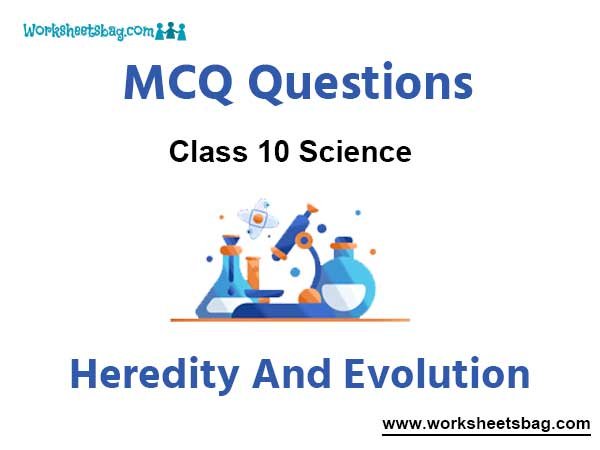Please refer to Heredity And Evolution MCQ Questions Class 10 Science below. These MCQ questions for Class 10 Science with answers have been designed as per the latest NCERT, CBSE books, and syllabus issued for the current academic year. These objective questions for Heredity And Evolution will help you to prepare for the exams and get more marks.
Heredity And Evolution MCQ Questions Class 10 Science
Please see solved MCQ Questions for Heredity And Evolution in Class 10 Science. All questions and answers have been prepared by expert faculty of standard 10 based on the latest examination guidelines.
MCQ Questions Class 10 Science Heredity And Evolution
Question: Some dinosaurs had feathers although they could not fly but birds have feathers that help them to fly. In the context of evolution this means that
a) reptiles have evolved from birds
b) there is no evolutionary connection between reptiles and birds
c) feathers are homologous structures in both the organisms
d) birds have evolved from reptiles
Answer
D
Question: In human males all the chromosomes are paired perfectly except one. This /these unpaired chromosome is/are:
i) Large chromosome ii) Small chromosome iii) Y chromosome iv) X chromosome
a) (i) and (ii)
b) (iii) only
c) (iii) and (iv)
d) (ii) and (iv)
Answer
C
Question: New species may be formed if
a) DNA undergoes significant changes in germ cells
b) chromosome number changes in the gamete
c) there is no change in the genetic material
d) mating does not take place
Answer
A
Question: Two pea plants one with round green seeds (RRyy) and another with wrinkled yellow (rrYY) seeds produce F1 progeny that have round, yellow (RrYy) seeds. When F1 plants are selfed, the F2 progeny will have new combination of characters. Choose the new combination from the following:
a) Round, yellow
b) Round, green
c) Wrinkled, yellow
d) Wrinkled, green
Answer
D
Question: Select the statements that describe characteristics of genes
a) genes are specific sequence of bases in a DNA molecule
b) a gene does not code for proteins
c) in individuals of a given species, a specific gene located on a particular chromosome
d) each chromosome has only one gene
Answer
A
Question: A Mendelian experiment consisted of breeding tall pea plants bearing violet flowers with short pea plants bearing white flowers. The progeny all bore violet flowers, but almost half of them were short.This suggests that the genetic makeup of the tall parent can be depicted as
a) TTWW
b) TTww
c) TtWW
d) TtWw
Answer
C
Question: Select the group which shares maximum number of common characters
a) two genera of two families
b) two species of a genus
c) two genera of a family
d) two individuals of a species
Answer
D
Question: An example of homologous organs is
a) our arm and a dog‘s fore-leg
b) our teeth and an elephant‘s tusks
c) potato and runners of grass
d) all of the above
Answer
B
Question: The sex of a child is determined by which of the following?
a) The length of the mother’s pregnancy
b) The length of time between ovulation and copulation
c) The presence of an X chromosome in an ovum
d) The presence of a Y chromosome in a sperm
Answer
D
Question: zygote which has inherited an X chromosome from the father will develop into :
a) Baby boy
b) Baby girl
c) Adult
d) Either boy or girl
Answer
B
Question: Two pea plants one with round green seeds (RRyy) and another with wrinkled yellow (rrYY) seeds produce F1 progeny having round, yellow (RrYy) seeds. When F1 plants are selfed, the F2 progeny will have the following combination of characters
a) 15:1
b) 9:3:3:1
c) 9:3:4
d) 12:3:1
Answer
B
Question: Some dinosaurs had feathers although they could not fly but birds have fathers that help them to fly. In the context of evolution this means that –
a) reptiles have evolved from birds
b) there is no evolutionary connection between reptiles and birds
c) feathers are homologous structure in both the organisms
d) Birds have evolved from reptiles
Answer
D
Question: A section of DNA providing information for one protein is called _____________
a) Nucleus
b) Chromosomes
c) Trait
d) Gene
Answer
D
Question: Which of the following scientist gave the principles of inheritance?
a) Mendel
b) Griffin
c) Johanssen
d) Watson and crick
Answer
A
Question: Which of the following statement is incorrect?
a) For every hormone there is a gene
b) For every protein there is a gene
c) For production of every enzyme there is a gene
d) For every type of fat there is a gene
Answer
D
Question: In evolutionary terms, we have more in common with
a) a Chinese school-boy
b) a chimpanzee
c) a spider
d) a bacterium
Answer
A
Question: Which of the following is not correct
a) For every hormone there is a gene
b) For every protein there is a gene
c) For production of every enzyme there is a gene
d) For every molecule of fat there is a gene
Answer
D
Question: Mendel proposed that every character is controlled by
a) one factor
b) two factors
c) one chromosome
d) two chromosomes
Answer
B
Question: According to the evolutionary theory formation of a new species occurs generally due to
a)Sudden creation by nature
b) accumulation of variations over several generations
c) clones formed during asexual reproduction
d) Movement of individuals from one habitat to another
Answer
B
Question: The ratio of each phenotype of the seeds of pea plants in the F2 generation is 9:3:3:1, it is known as:
a) Tetra hybrid ratio
b) Monohybrid ratio
c) Dihybrid ratio
d) Tri hybrid ratio
Answer
C
Question: When two parents are crossed, the offspring are referred to as :
a) Recessive
b) Test cross
c) F1 generation
d) F2 generation
Answer
C
Question: Two pink colored flowers on crossing results in 1red, 2pink and 1white flower progeny. The nature of the cross is –
a) cross fertilization
b) self-pollination
c) double fertilization
d) no fertilization
Answer
A
Question: A normal cell of human body contains 23 pairs of chromosomes. The number of chromosomes in a sex cell (Sperm or ovum) of a human being is most likely to be:
a) 46
b) 23
c) 21
d) 42
Answer
B
Question: A basket of vegetable contains carrot, potato, radish, and tomato. Which of them represent the correct homologous structure
a) carrot and potato
b) carrot and tomato
c) radish and carrot
d) radish and potato
Answer
C
Question: Select the group which shares maximum number of common characters
a) two individual of a species
b) two species of a genus
c) two genes of a family
d) two genera of two families
Answer
A
Question: The science of heredity is known as:
a) Biology
b) Embryology
c) Genetics
d) Biochemistry
Answer
C
Question: Mendel used for his experiments on heredity:
a) Papaya plants
b) Potato plants
c) Pea plants
d) Pear plants
Answer
C
Question: A gene is a:
a) Hybrid
b) Heritable trait
c) Pure breed
d) Part of a chromosome that transmits a trait
Answer
D
Question: In order to ensure that he had pure-breeding plants for his experiments, Mendel:
a) Cross-fertilized each variety with each other
b) Let each variety self-fertilize for several generations
c) Removed the female parts of the plants
d) Removed the male parts of the plants
Answer
B
Question: A pregnant woman has an equal chance of her baby being blood group A or blood group AB. Which one of the following shows the possible genotypes of the woman and the father of her child?
a) IAIA and IB IO
b) IA IB and IB IO
c) IA IO and IB IO
d) IA IB and IA IO
Answer
A
Question: In the human blood grouping, the four basic blood types are type A, type B, type AB, and type 0. The blood proteins A and B are:
a) Simple dominant recessive traits
b) Incomplete dominant traits
c) Co-dominant traits
d) Sex-linked traits
Answer
C
Question: The human animal which has an XY pair of chromosomes is called:
a) Male
b) hybrid
c) Female
d) Doomed
Answer
A
Question: plant with two ‘small’ genes breeds with a plant with two ‘tall’ genes to produce:
a) Small plants and tall plants in the ratio 1:3
b) All small plants
c) All tall plants
d) Tall plants and small plants in the ratio 3:1
Answer
C
Question: The palisade cells of a species of plant contain 28 chromosomes. How many chromosomes will there be in each gamete produced by the plant?
a) 56
b) 28
c) 14
d) 4
Answer
C
Question: Which of the following may be used to obtain an F2 generation?
a) Allowing flowers a parent plant to be self-pollinated
b) Allowing flowers on an F1plant to be self-pollinated
c) Cross-pollinating an F1 plant with a parent plant
d) Cross-pollinating two parent plants
Answer
A
Question: The exchange of genetic material takes place in:
a) Vegetative reproduction
b) Asexual reproduction
c) Sexual reproduction
d) Budding
Answer
C
Question: The following results were obtained by a scientist who crossed the F1 generation of pure-breeding parents for round and wrinkled seeds.
Dominant trait – Round seeds
Recessive trait -Wrinkled seeds
No. of F2 offspring -7524
From these results, it can be concluded that the actual number of round seeds he obtained was:
a) 1881
b) 22572
c) 2508
d) 5643
Answer
D
Question.

The figure above shows :
a) A bird sitting on a tree
b) Connection between Birds and Reptiles
c) Connection between Pisces and Aves
d) All of the above
Answer
B
Question. If a homozygous red-flowered plant is crossed with a homozygous white-flowered plant, the offspring would be:
a) Half red-flowered
b) Half white-flowered
c) All red-flowered
d) Half pink-flowered
Answer
C
Question. A pair of contrasting characters is called
a) phenotype
b) genotype
c) allele
d) gene
Answer
C
Question. Which of the following would stop evolution by natural selection from occurring?
a) If humans became extinct because of a disease epidemic.
b) If a thermonuclear war killed most living organisms and changed the environment drastically.
c) If ozone depletion led to increased ultraviolet radiation, which caused many new mutations.
d) If all individuals in a population were genetically identical, and there was no genetic recombination, sexual reproduction, or mutation.
Answer
D
Question. Normal maize has starchy seed which remain smooth when dry. A mutant form has sugary seed which go crinkled when dry. When a mutant was crossed with a normal plant, an F1 was produced which had smooth seeds. What would be the relative ratios of the different seed types, if the F1 was allowed to self
a) 1 smooth : 3 sugary
b) 3 smooth : 1 sugary
c) 1 smooth : 1 sugary
d) All sugary
Answer
C
Question. Mendel formulated the law of purity of gametes on the basis of :
a) Dihybrid cross
b) Monohybrid cross
c) Back cross
d) Test cross
Answer
B
Question. Vestigial organs are:
a) Primitive organs
b) Primordial organs
c) Organs reduced due to disuse
d) Organs marked only in embryonic stage
Answer
C
Question. Which of the following is a test cross?
a) TT × tt
b) Tt × tt
c) Tt × TT
d) tt × tt
Answer
B
Question. The diagram below represents a portion of a nucleic acid molecule.

The part indicated by arrow X could be
a) adenine
b) ribose
c) deoxyribose
d) phosphate
Answer
A
Question. Who out of the following was of the strong opinion that acquired characteristics are inherited:
a) Lamarck
b) Lysenko
c) Mendel
d) Huxley
Answer
A
Question: The number of pair(s) of sex chromosomes in the zygote of humans is:
a) One
b) Two
c) Three
d) Four
Answer
A
Question: The two versions of a trait (character) which are brought in by the male and female gametes are situated on:
a) Copies of the same chromosome
b) Sex chromosomes
c) Two different chromosomes
d) Any chromosomes
Answer
A
Question: In peas, a pure tall plant (IT) is crossed with a pure short plant (tt). The ratio of pure tall plants to pure short plants in F2 generation will be:
a) 1 : 3
b) 3 : 1
c) 1 : 1
d) 2 : 1
Answer
C
Question: The visible characteristic in an organism is known as:
a) Prototype
b) stereotype
c) Phenotype
d) Genotype
Answer
C
Question: From the list given below, select the character which can be acquired but not inherited:
a) colour of eye
b) colour of skin
c) size of body
d) nature of hair
Answer
C
Question: A cross between a tall plant (TT) and short pea plant (tt) resulted in progeny that were all tall plants because
a) tallness is the dominant trait
b) shortness is the dominant trait
c) tallness is the recessive trait
d) height of pea plant is not governed by gene ‘T‘ or ‘t‘
Answer
A
Question: A trait in a organism is influenced by
a) paternal DNA only
b) maternal DNA only
c) both maternal and paternal DNA
d) neither by paternal nor by maternal DNA
Answer
C
Question: According to the evolutionary theory, formation of a new species is generally due to
a) sudden creation by nature
b) accumulation of variations over several generations
c) clones formed during asexual reproduction
d) movement of individuals from one habitat to another
Answer
B
Question: Which of the following statement is incorrect?
a) For every hormone there is a gene
b) For every protein there is a gene
c) For production of every enzyme there is a gene
d) For every molecule of fat there is a gene
Answer
D
Question: The two versions of a trait (character) which are brought in by the male and female gametes are situated on
a) copies of the same chromosome
b) two different chromosome
c) sex chromosomes
d) any chromosome
Answer
A
Question: A cross between a tall plant (TT) and short pea plant (tt) resulted in progeny that were all tall plants because
a) tallness is the dominant trait
b) shortness is the dominant trait
c) tallness is the recessive trait
d) height of pea plant is not governed by gene ‘T‘ or ‘t‘
Answer
A
Question: Following has (have) been used for studying human evolution
a) excavating
b) time dating
c) determining DNA sequences
d) all of the above
Answer
D
Question: The rules of ___ determine the process by which traits and characteristics are reliably inherited
a) heredity
b) reproduction
c) generation
d) none of the above
Answer
A
Question: The earliest members of the human species, Homo sapiens can be traced from
a) West Asia
b) Australia
c) East Asia
d) Africa
Answer
D
Question: Two pink coloured flowers on crossing resulted in 1 red, 2 pink and 1 white flower progeny. The nature of the cross will be
a) double fertilisation
b) self pollination
c) cross fertilisation
d) no fertilisation
Answer
C
Question: Following is (are) descended from wild cabbage
a) red cabbage
b) broccoli
c) cauliflower
d) all of the above
Answer
D
Question: The preserved traces of living organisms are called
a) fossils
b) species
c) non-living materials
d) none of the above
Answer
A
Question: The frequency of certain genes in a population changed over generations. This is the essence of theidea of ____________ .
a) revolution
b) evolution
c) reproduction
d) production
Answer
B
Question: Following have four limbs
a) mammals
b) amphibians
c) reptiles
d) all of the above
Answer
D
(a) If both Assertion and Reason are correct and Reason is the correct explanation of Assertion.
(b) If both Assertion and Reason are correct, but Reason is not the correct explanation of Assertion.
(c) If Assertion is correct but Reason is incorrect.
(d) If Assertion is incorrect but Reason is correct.
Question. Assertion: We have lost all the direct evidence of origin of life.
Reason: The persons responsible for protecting evidences were not skilled.
Answer
C
Question. Assertion: Among the primates, chimpanzee is the closest relative of the present day humans.
Reason: The banding pattern in the autosome numbers 3 and 6 of man and chimpanzee is remarkably similar.
Answer
A
Question. Assertion: Human ancestors never used their tails and so the tail expressing gene has disappeared in them.
Reason: Lamarck’s theory of evolution is popularly called theory of continuity of germplasm.
Answer
C
Question. Assertion: Although living organism always arise from other living organism, life should certainly have had a beginning.
Reason: The study of the conditions and the mechanisms involved in the creation of most primitive living structures on earth is actually the problem of origin of life.
Answer
A
Question. Assertion: The birds have large, light spongy bones with air sacs.
Reason : These adaptations help them during flight.
Answer
A



